Located in Utah, Bryce Canyon National Park is the national park in the United States that surprised me the most on my road trip through the Southwest region. There’s no doubt that its viewpoints are jaw-dropping, but can you imagine doing the best hike in Bryce Canyon?

The Navajo Loop Trail, which can be combined with the Queen’s Garden Trail, is a different and unique way to explore this park. Descending into the Bryce Canyon valley, you’ll have the chance to see the hoodoos up close and the landscapes from a different perspective.
✨ FUN FACT: What is so characteristic of the Bryce Canyon landscape and attracts so many visitors are its rock formations, known as hoodoos. Hoodoos are tall, narrow rock spires formed by erosion. This type of formation exists in various places around the world (such as Cappadocia in Turkey), but it is in Bryce Canyon that we find a larger concentration of this type of rock formation.
There are other hikes in Bryce Canyon National Park, but this is probably the best and most interesting, especially for first-time visitors.

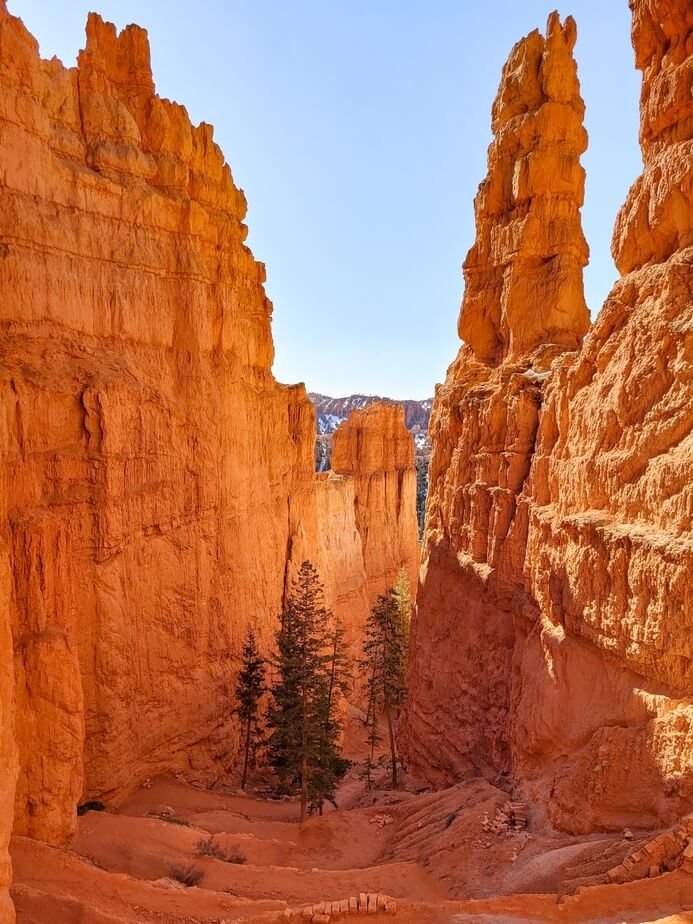
So keep reading to find out all the tips for hiking one of the best trails in Bryce Canyon.
Best time to do the best hike in Bryce Canyon
Since Bryce Canyon is located at a high altitude, it never gets extremely hot in Bryce Canyon, with winter being the harshest season in this park. Given the frequent presence of snow at this altitude, this trail has some parts closed during the colder months (notably the Wall Street part).
For example, when I visited the park at the beginning of April, parts of the trail were closed because there was still a lot of snow and mud, which made the trail more dangerous. I suggest checking the official website for possible trail closures, as it depends on the weather each year.
The best months to hike the Queen’s Garden and the Navajo Loop trails are June, September and October because there is no snow, temperatures are milder and there aren’t as many visitors as in summer.
Hiking Queen’s Garden and Navajo Loop Trail – Summary
- Start of the trail: Sunrise Point or Sunset Point
- Distance: 4.6 km (2.9 mi)
- Recommended duration: 2 to 3 hours
- Difficulty: moderate due to some of the trail’s uphill sections
- Elevation: 191 meters (625 ft)
- Parking is available at Sunrise Point or Sunset Point car parks
- Part of the Navajo Loop is closed in winter (the Wall Street part)
Hiking Queen’s Garden and Navajo Loop Trail – Step-by-step guide
Parking at Sunset Point
The first step is to decide where you want to start the trail. You can start this trail at 2 different places: Sunrise Point or Sunset Point. I recommend parking at Sunset Point. There are several parking spaces, but in the busier months, I suggest arriving early as this is the most popular trail in Bryce Canyon. Alternatively, you can also use the free shuttle that is included in Bryce Canyon’s entrance fee.
Hike part of Rim Trail to Sunrise Point
Starting at Sunset Point, you can hike part of the Rim Trail until you reach Sunrise Point. The Rim Trail is one of the easiest trails in Bryce Canyon and this part adds only 0.8 km (0.5 mi) to the Navajo Loop and Queens Garden’s trail.
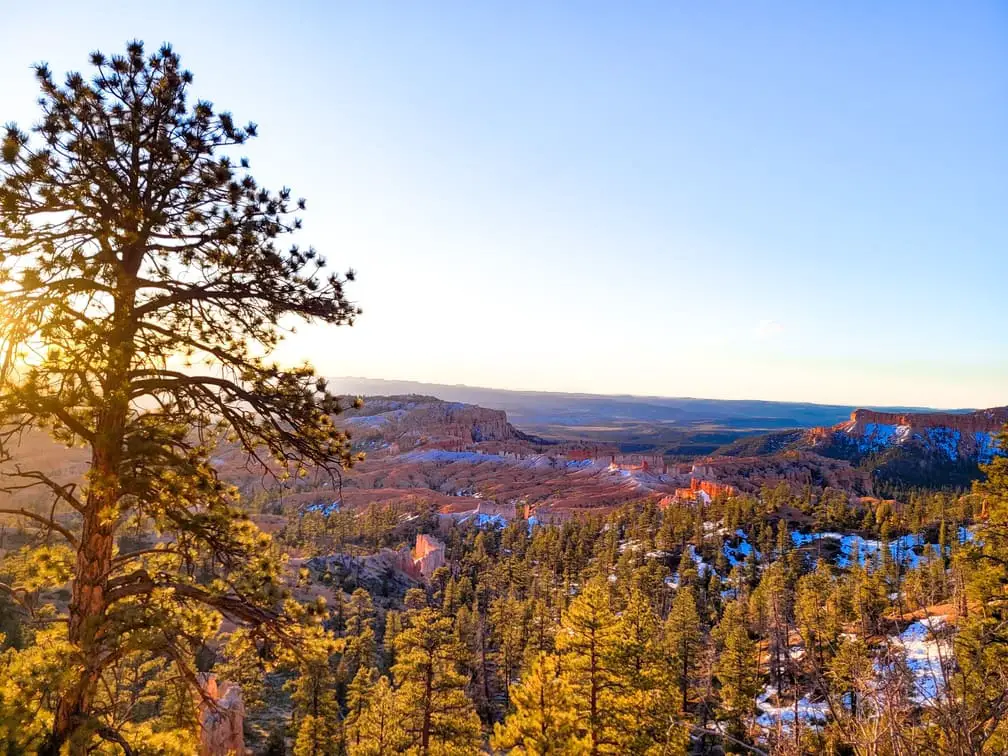
Hike Queen’s Garden Trail
When you arrive at Sunrise Point, you’ll see signs for the Queen’s Garden Trail. The first part of the trail is mostly downhill. It’s about 1.4 km (0.9 mi) until you reach Bryce Canyon valley.


As soon as you start descending into the valley, you’ll start seeing Bryce Canyon from a different perspective, with the hoodoos even closer. Prepare to be amazed!
After this initial part, you can continue along the Queen’s Garden Trail for another 1.3 km (0.8 mi).
Continue towards Navajo Loop
At some point along the way, you’ll see a fork with signs indicating the way towards the Navajo Loop. Go that way! However, you’ll have to make a choice. The Navajo Loop, as the name suggests, is a loop trail that begins and ends at Sunset Point.
The Navajo Loop has two distinct sections: a section that passes through Wall Street (the only slot canyon in Bryce Canyon) and another part that passes through Thor’s Hammer and the Two Bridges.

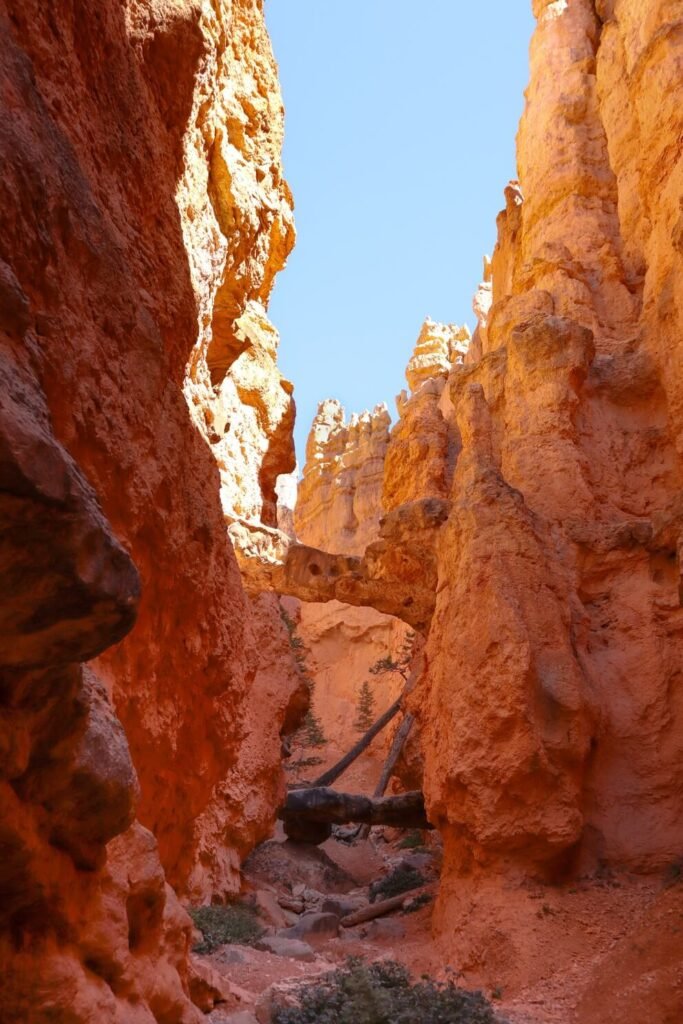
If you’re combining the Queen’s Garden Trail with the Navajo Loop, it makes the most sense to choose just one of the Navajo Loop sections. Depending on the time of year you’re visiting Bryce Canyon, you may not even have to choose, since the Wall Street section is closed most of the year.
In any case, the distances you have to hike on both sides are identical. On the Wall Street side, the way back to Sunset Point is 1.1 km (0.7 mi). On the other hand, if you take the Navajo Loop section that passes through Two Bridges and Thor’s Hammer, the route is slightly shorter (1 km, 0.6 mi).


As I visited in April and there was still a lot of snow in the park, the Wall Street part was still closed, so I ended up doing the section of the Two Bridges and Thor’s Hammer. The path is mostly uphill, but it’s relatively easy to hike it nevertheless. Honestly, the hardest part was getting through some parts that were muddy and slippery.
If you’re lucky enough to be visiting the park at a time when it’s possible to visit Wall Street, once you‘ve reached the end of the trail, I suggest taking a short walk along the other part of the Navajo Loop to visit Thor’s Hammer, as this is probably one of the most famous hoodoos in the park.
I think the combination of these two trails is quite intuitive, but even so, here’s a map of the trail to help you understand the distances between its various points of interest.

Alternatively, the trail can be hiked in reverse order, starting at Sunset Point, thus doing the Navajo Loop part first and then the Queen’s Garden Trail. However, even then, the trail will always have some uphill parts.
💼 TRAVEL INSURANCE: Unexpected events happen anywhere in the world, so I always recommend getting travel insurance. I regularly use Heymondo, which offers some of the highest coverages on the market at very competitive prices. As well as covering medical expenses, Heymondo’s insurance also covers the loss or theft of luggage, electronic equipment and more. They also have a 24/7 customer service through their App. As A Ticket to Take Off reader, you get a 5% discount when purchasing Heymondo insurance. The purchase must be made using this link, and the price shown on the website already includes the discount.
Other tips about Bryce Canyon National Park
What else to see in Bryce Canyon National Park
When I did my road trip through the Southwest region in the US, Bryce Canyon was the park that surprised me the most. It may not even be one of the largest, but it was certainly the most beautiful.
So, if you’d like to know more about the best things to do in Bryce Canyon National Park and how you can organize your itinerary, I suggest reading my complete guide to Bryce Canyon.
How many days do you need in Bryce Canyon?
Bryce Canyon is a small park, covering just 145 square kilometres. So, the ideal duration to visit the main attractions in Bryce Canyon is between half a day to one full day.
In half a day, you’ll have the opportunity to visit the best viewpoints in the Bryce Canyon amphitheatre and also do one of the best hikes in Bryce Canyon: Navajo Loop and Queen’s Garden Trail.

If you have a full day to visit the park, you can extend your visit to lesser-known places in the park and take the opportunity to hike other trails, for example.
In my case, I ended up spending just one morning in the park and that was all I needed to see the main sights, including the trail I mentioned in this post.
What is the best time of year to visit Bryce Canyon?
Bryce Canyon is located at a fairly high altitude (over 2400 metres/8000 ft) and for this reason, the temperatures in the park are quite low all year round.
In winter, it even snows, so some trails (or parts of them) are closed. However, although the snow might be inconvenient to those who visit Bryce Canyon, the truth is that it makes the landscapes even more magical. The snow-covered hoodoos are even more special 😍.
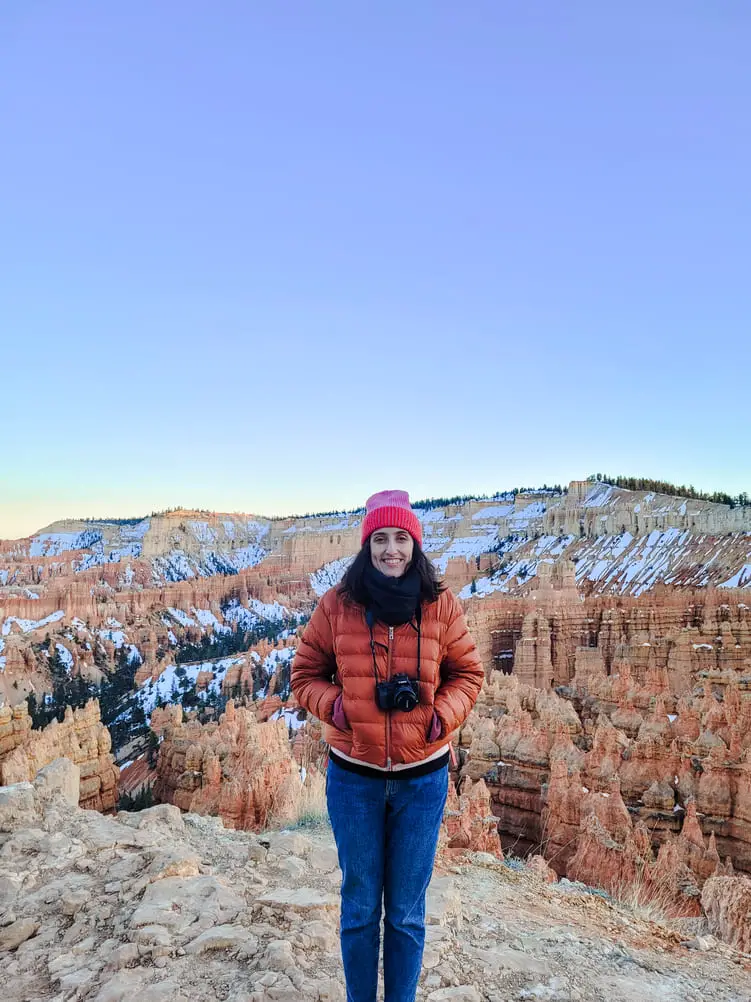

So, the best time to go to Bryce Canyon is probably spring (April to June) and autumn (September and October). As well as the temperatures being more bearable in these months, the park receives fewer tourists. July and August are when the temperatures are highest, but this is also the time with the most visitors in the park. In addition, July and August are also the wettest months.

To give you an idea, I visited in the first half of April and there was still snow in the park, so some trails were closed. What’s more, it was freezing when I visited (0 °C/32 °F, with a real feel of -5 °C/23 °F).
Temperatures are more acceptable during the day, especially if you’re hiking any of the trails. However, if you’re planning to visit Bryce Canyon, the best advice I can give you is to take warm clothes, as you’ll really need them 😉. Check out the official website for more information on the weather in Bryce Canyon.
How much does it cost to visit Bryce Canyon?
You have to pay to enter Bryce Canyon. There are various entrance tickets and passes available. For example, entrance fees with a private vehicle are 35 USD (the price is per vehicle, not per person). This entrance fee gives you access to the park for 7 days! There is also an annual pass which costs 70 USD.

However, if you wish to visit other national parks in the United States, other options are more worthwhile. One such example is the America the Beautiful annual pass. This pass costs 80 USD per vehicle and is valid for one year for all the national parks in the country. Given the average price of entry to the various parks, you only need to visit 3 national parks in a year to make it worth buying America the Beautiful! More information about the passes is available here.

Any of these tickets or passes can be bought at the entrances to the various national parks. I should warn you, however, that some entrances/parks may only accept card payments. In the case of Bryce Canyon, they accept both card and cash payments. You can also buy your entrance tickets online if you wish to spend less time queuing to enter the park😉.
If you choose to buy the America the Beautiful annual pass, once you’ve bought it, you’ll need to show your pass and ID when entering each park, as the pass is non-transferable.
Accommodations near Bryce Canyon
Accommodation outside Bryce Canyon
Bryce Canyon City is an excellent option for looking for accommodation outside the park and this is where some of the best places to stay near Bryce Canyon are located. You can also use the shuttle bus to get to the park and also to explore its main points of interest.
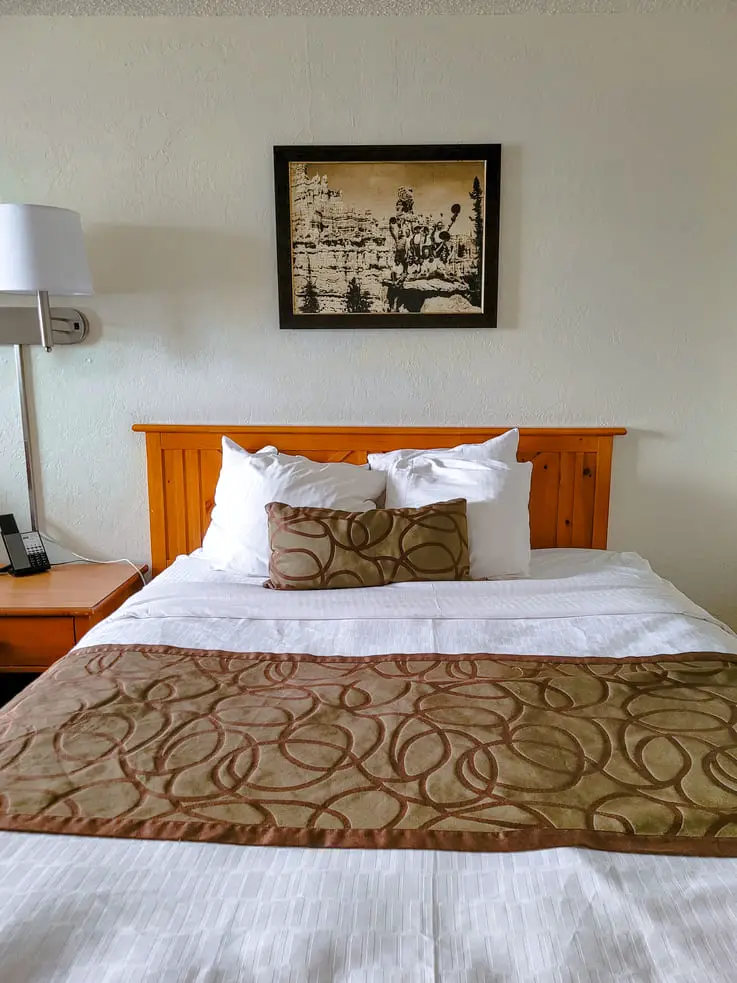

In my case, I chose to stay at Bryce View Lodge. This accommodation is a basic motel and I confess that the main reason for choosing it was its proximity to the park entrance, as it’s less than 10 minutes away by car.
Anyway, the room was comfortable and breakfast was included. The price for one night for two people was 75€.
The small town of Tropic is another of the best places to stay near Bryce Canyon, as it’s less than 15 minutes by car from the park’s entrance.
In any case, I’d like to share some additional suggestions for accommodation near Bryce Canyon:
Accommodation inside Bryce Canyon
There is also accommodation inside the park – Bryce Canyon Lodge, which is usually open from Spring to Autumn. As this is the only accommodation inside the park, if this is where you want to stay, you should book as far in advance as possible.
Alternatively, it is also possible to camp at Bryce Canyon. There are two campsites: North Campground and Sunset Campground. North Campground is open all year round, while the other campground is closed from November to April. At certain times of the year, you have to book a place at the campsite. I suggest you read the updated information on camping in Bryce Canyon.
Tips to hike Navajo Loop and Queen’s Garden Trail
The combination of the Navajo Loop Trail and the Queen’s Garden Trail can be one of the most interesting activities in Bryce Canyon. However, depending on the weather conditions at the time of your visit, you should consider some things. These are some of the park’s official recommendations:
- Bryce Canyon is located at an altitude of over 2400 metres, so it’s usually cold. You should wear suitable clothing, especially in winter.
- In winter and early spring, you are likely to encounter snow and mud (when the snow starts to melt) along the trail. Wearing appropriate footwear and walking carefully is recommended.
- The part of the Navajo Loop that passes by Wall Street is closed in the winter (this often extends into the spring months). It is essential to comply with the rules set by the park.
- Ensure the necessary hydration while hiking the trail, especially in the warmest months.
- Given the altitude at which the park is located, it’s normal to feel more tired when walking the trails.
- On days with fewer hours of daylight, make sure you return from the trail when there is still light, since it gets dark earlier.
- Especially in July and August, watch out for thunderstorms. If it thunders, seek shelter in a building or car, avoiding trees, hoodoos or other tall objects.
- If you’re going to walk a trail alone, tell someone you know that you’re doing it.
Finally, don’t forget the Leave No Trace principle, by complying with its 7 principles: prepare your visit in advance, dispose of rubbish in appropriate places, leave everything the same way as you found it, minimise the impact of any campfires, respect wildlife, be respectful to other visitors and comply with the camping rules.
Disclaimer: this post may contain some affiliate links, which means I get a small commission if you buy something through my links. This doesn’t represent any additional cost to you and you’ll be supporting my work here on the blog😊









